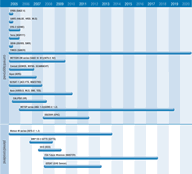Trace gases (excluding ozone)
Trace gases other than ozone may be divided into three categories:
- greenhouse gases affecting climate change;
- chemically aggressive gases affecting the environment (including the biosphere);
- gases and radicals impacting on the ozone cycle, thereby affecting both climate and environment.
The presence of trace gases in the atmosphere can have a significant effect on global change as well as potentially harmful local effects through increased levels of pollution. The chemical composition of the troposphere in particular is changing at an unprecedented rate - the rate at which pollutants from human activities are being emitted into the troposphere is now thought to exceed that from natural sources (such as from volcanic eruptions).
The IPCC notes large increases in atmospheric concentrations of carbon dioxide (CO2), methane (CH4) and nitrous oxide (N2O) since the industrial era and suggests that emissions of CO2 due to fossil fuel burning are virtually certain to be the dominant influence on the trends in atmospheric CO2 concentration during the 21st century. They consider that reductions in greenhouse gas emissions and the gases that control their concentration would be necessary to stabilise radiative forcing.
Measurements from satellite sensors have already made an important contribution to the recognition that human activities are modifying the chemical composition of both the stratosphere and the troposphere, even in remote regions.
A variety of instruments provide measurements on the concentration of trace gases. In general, high spectral resolution is required to detect absorption, emission and scattering from individual species. Some instruments offer measurements of column totals, ie integrated column measurements, whilst others provide profiles of gas concentration through the atmosphere (usually limited to the upper troposphere and stratosphere using limb measurements).
To date, the instruments on UARS, launched in 1991 have provided the most significant source of data on trace gases and have been vital for studies of stratospheric chlorine chemistry, stratospheric tracer-tracer correlation, tropospheric water vapour, the chemistry of the wintertime Arctic lower stratosphere, and tropospheric aircraft exhaust studies.
The last few years have seen the arrival of new and significant capabilities, with advanced instruments on Terra (MOPITT - providing global measurements of carbon monoxide and methane in the troposphere), and Envisat (GOMOS, MIPAS, SCIAMACHY - providing profiles of trace gases through the stratosphere and troposphere). On NASA's Aura mission, HiRDLS, an infrared limb-scanning radiometer, carries out soundings of the upper troposphere, stratosphere and mesosphere to determine concentrations of trace gases, with horizontal and vertical resolutions superior to those previously obtained. On the same mission MLS measures concentrations of trace gases for their effects on ozone depletion, TES provides a primary input to a database of 3D distribution on global, regional and local scales of gases important to tropospheric chemistry, and OMI continues the TOMS record for atmospheric parameters related to ozone chemistry and climate. JAXA’s GOSAT mission (from 2008) and EUMETSAT’s METOP series (from late 2005) are also expected to make significant contributions to observations of trace gases.
The IGOS IGACO Theme for observations of atmospheric chemistry has considered all relevant chemical species to properly interpret the observations and intends to monitor the research required to improve understanding of Earth processes so that air quality evolutions can be predicted.

